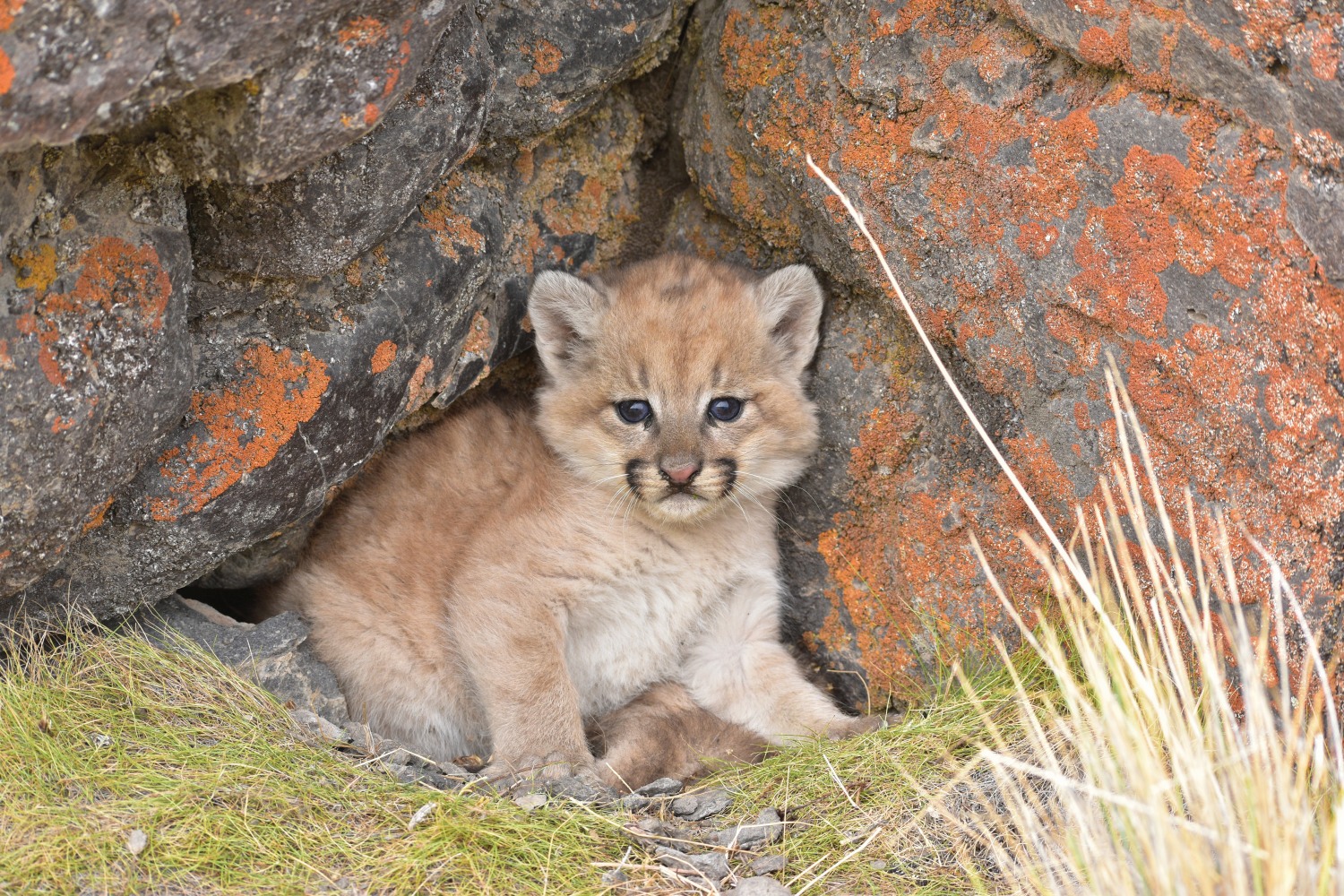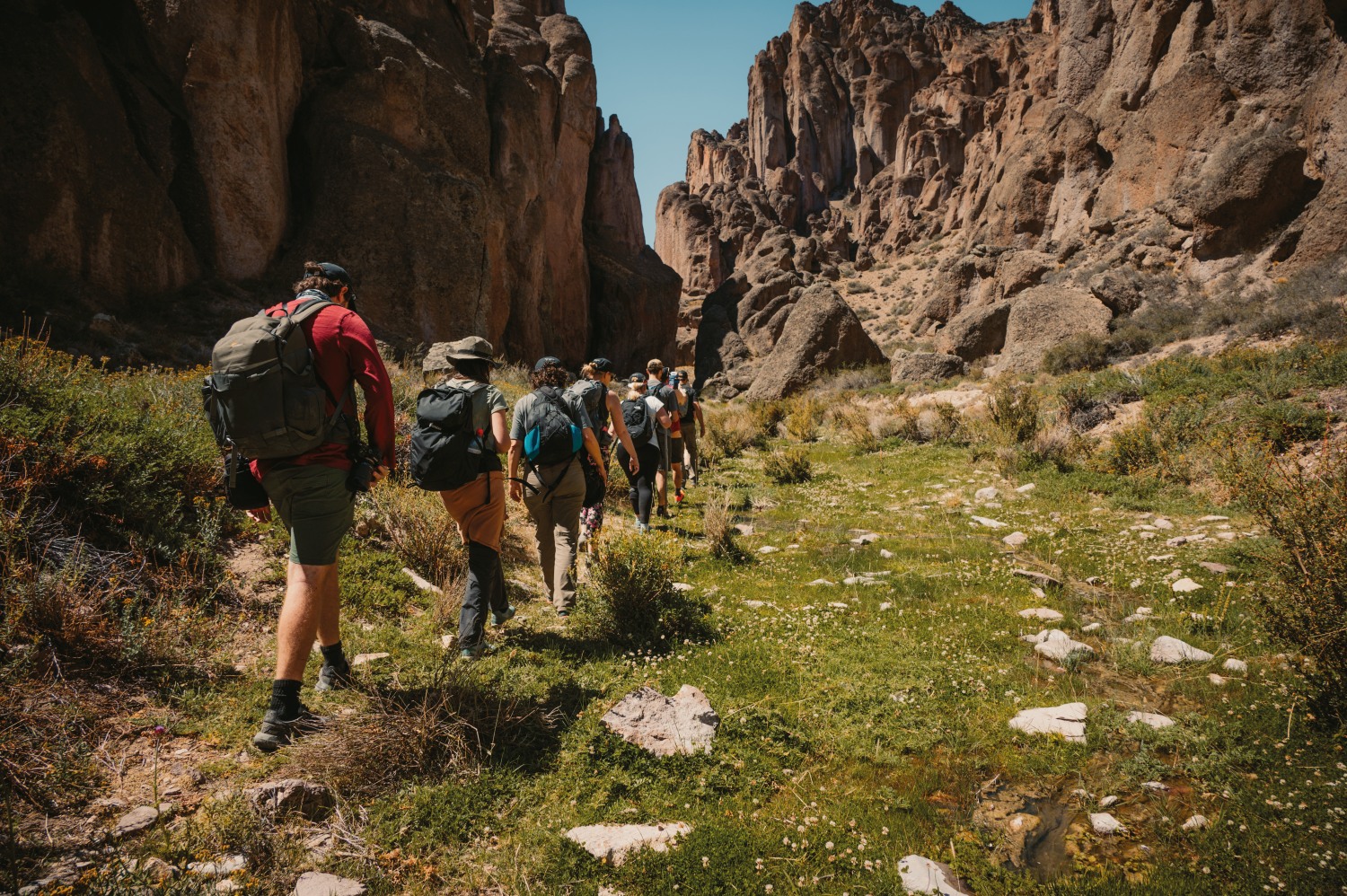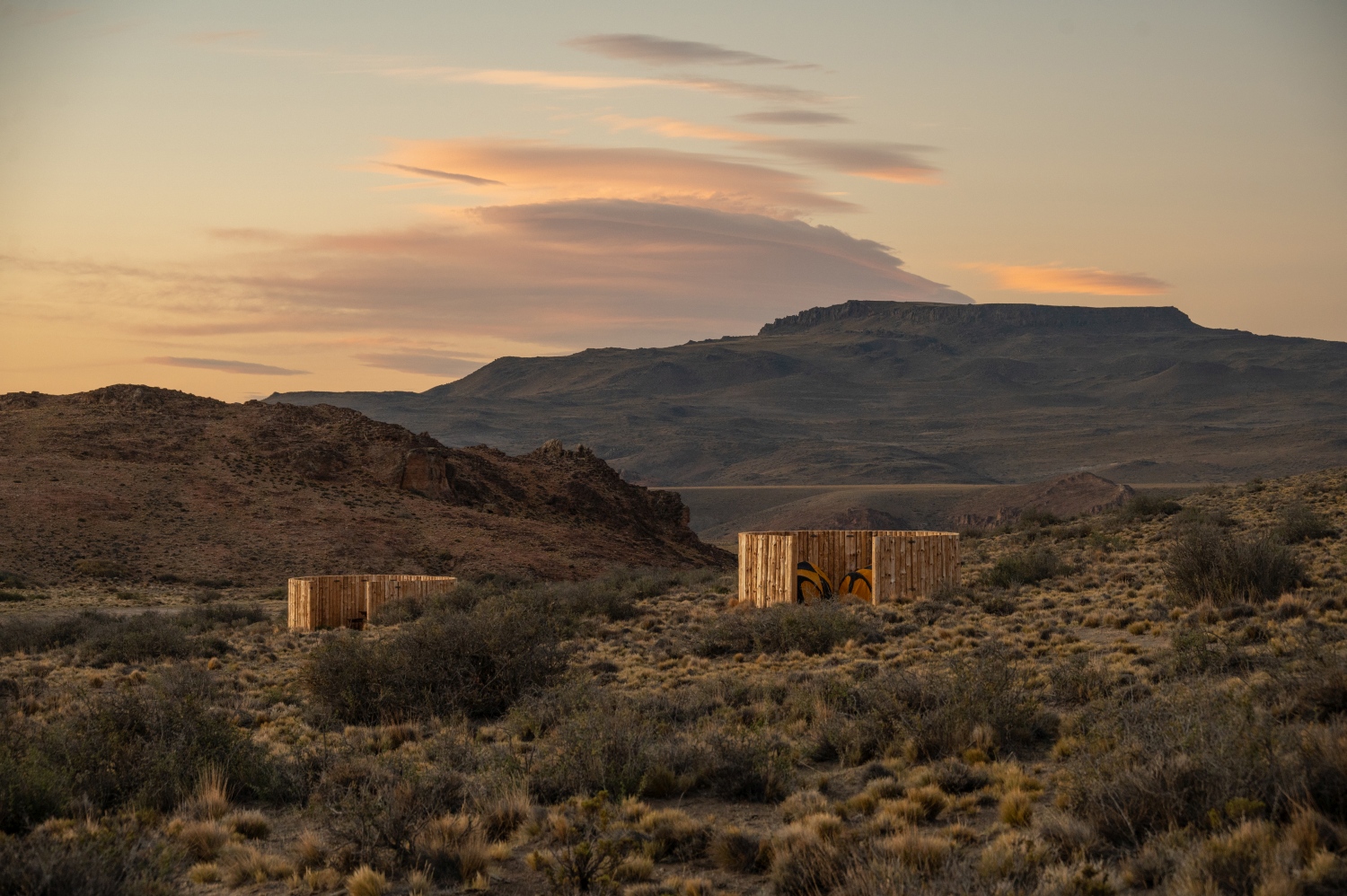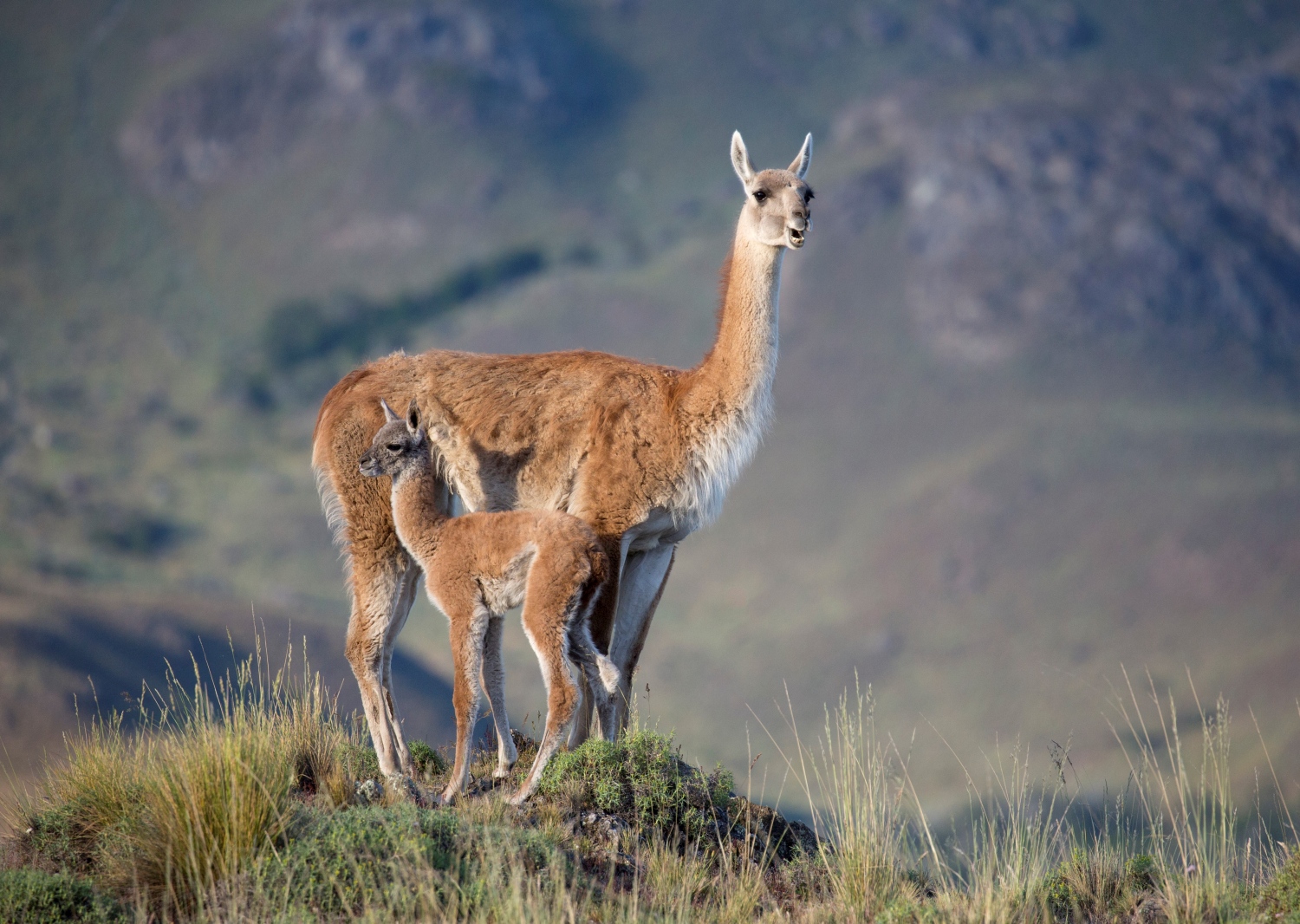"Some ranchers say it's important to kill pumas, because they threaten your business,” says Facundo Epul, as we rattle through the dusty steppe of Parque Patagonia Argentina in his old pickup truck. “They say it's important to protect the sheep. When I was a child, I lived with a leonero [a man paid by ranchers to kill pumas] and I know five leoneros who still work here today.”
Epul is 27 years old, and wears a boina, a traditional Argentinian beret. He was born in Perito Moreno, a small mining town near this remote national park, where cypress trees shield the locals from the worst of the Patagonian winds. Despite coming from a long line of ranchers, Epul bucked the trend to start his own business: El Choique Guía, the first company in Argentina offering puma-tracking tours. “I look for pumas with tourists, not dogs,” laughs Facundo. “It’s a change.”
We pull up at a seemingly random spot in the semi-arid wilderness and start our hike in silence. “If you talk, pumas run,” Epul says. “And no zips. They hate zips,” he warns. We dodge clumps of spiky bluegrass on the trail, keeping an eye open not only for pumas ahead of us, but for black widow spiders below.
Our first sign of the big cats comes in the form of a carcass. The hiking trails of Parque Patagonia are littered with the skeletons of guanacos, a cute, clumsy-faced ancestor of the llama. But this carcass is fresh. Epul estimates the kill is one day old.
The puma that made the kill has covered the half-eaten animal with sticks and leaves to hide it from the Andean condors—huge birds, easily identifiable by the distinctive white stripe across their three-metre wingspan—which circle in the skies above. This suggests the puma will still be lurking in the area, Epul says. “They are creatures of habit.” We hike on, stopping at a bend in the trail, where Epul crouches to the ground and circles a small paw print in the soil. “Puma cubs,” he says. “These prints are fresh. They’re near.”

As we clear an unassuming hill, a colossal canyon reveals itself on the other side, dropping hundreds of metres down to the dry riverbed below. Such geological marvels are not uncommon in Parque Patagonia. The scorching, flat steppe is vast but when it does relent, it does so dramatically, rising suddenly to flat-topped volcanic plateaus or falling into one of these vertigo-inducing gorges. The overall effect makes the area feel more like John Wayne country than southern Argentina.
An adult puma can weigh up to 100kg, but they’re ambush predators, stalking their prey, so stealth is crucial. With their sand-coloured fur, the cats blend in perfectly with this landscape. This helps them hunt but, unfortunately for us (and for the guanacos), it also makes them difficult to spot. Epul pushes on, but despite our silence, and further visible paw prints, the pumas evade us. It’s only when we sit down for lunch an hour later that we finally spot one—an adult female, lying lazily in a cave 100 metres away. The sleepy cat looks back at us, yawns, then beds down for a nap.

A land of new opportunities
Parque Patagonia Argentina is not an easy place to get to. The national park is situated 1,300 miles south of Buenos Aires. The nearest commercial airport is in Comodoro Rivadavia, an oil town on the San Jorge Gulf, an inlet of the Atlantic Ocean five-hours drive away.
The park does sit on Route 40— a legendary 3,246-mile road which runs from La Quiaca in the north of Argentina to Punta Loyola in the far south. But historically, most visitors have been day-trippers, stopping off only briefly to see Cueva de las Manos (the Cave of the Hands), where 9,300-year-old, UNESCO-protected cave paintings are perfectly preserved on the cliffs.
Geographical isolation means that job opportunities in this part of Patagonia are limited. You can be a rancher, a gold miner, or you can follow in the footsteps of many and migrate to a city, hundreds of miles away. Those options expanded substantially when the Fundación Rewilding Argentina arrived, and began buying up and restoring large swathes of abandoned farmland. Together with the philanthropic Freyja Foundation (who help to fund all the rewilding activity and infrastructure in the park) they’ve established a 40km network of hiking trails in the park, as well as campsites, ecolodges, and the jobs that come with them.

Facundo Epul is one of those who has benefitted. “I originally moved to Córdoba to study,” he says, “then a course was offered here by the foundation. I didn’t want to work on a ranch—you work for other people, and you don’t get much money—so I didn’t see myself coming back here. If it wasn’t for the rewilding project, it’s unlikely that I would have. But I love this area. And it’s an important moment for this place now.”
“If it wasn’t for Rewilding Argentina, it’s unlikely I would have come back here”
Sebastián Di Martino is the Conservation Director of Rewilding Argentina. “When the Europeans came to Argentina in the 1600s, we started to lose our big species,” he says. “Now we’re trying to reverse this wildlife extinction crisis by restoring complete and fully-functioning ecosystems. We want all of the species which were historically here to be present again.” You don’t need long in the park to see the results of their work. The llama-like guanacos roam in herds of hundreds. Wolffsohn’s viscachas (a sort of squirrel-rabbit hybrid) hide on the cliff faces. Lesser rhea (mini ostrich-like creatures) kick up dust as they sprint around the steppe, and condors soar, looking for those puma leftovers.
“Pumas are a keystone species,” says Di Martino. “They regulate the numbers of guanacos, and by doing so they provide carrion for birds. The condors couldn’t be here if the pumas didn’t offer them a source of food throughout the year. Without pumas, the vegetation suffers, because the guanacos graze a lot, and there are big numbers of grey fox, so small birds and mammals start to disappear. Without pumas, the whole ecosystem here degrades.” Rewilding Argentina has had a presence in the area since 2007, when they joined forces with locals to protect the nearby breeding grounds of the endangered hooded grebe. By 2012, they had secured the rights to important nesting sites for the species. After they donated the land in 2014, Parque Patagonia became a national park in law.
“The vision is to connect the park to Patagonia National Park on the Chilean side, creating a wildlife corridor,” says Sofia Heinonen. The CEO of Rewilding Argentina, she was named as one of the BBC’s 100 most inspiring and influential women in the world in 2022. The foundation occasionally comes into conflict with mining companies, who destroy the landscape while looking for gold. But “miners are seen as the bad guys in Argentina,” Heinonen says. Ranchers—concerned that an increase in puma numbers will mean a decrease in livestock numbers—are the trickier issue.

“Ranchers are the most important people in the country,” Heinonen explains. “They don’t have much money, but they have a lot of contacts, so they have power against policy.” There are, however, local farmers who are happy with the sheep dogs being provided by Rewilding Argentina to fend off pumas, meaning relationships have improved in recent years. New research proving that the majority of pumas don’t actually eat sheep has also helped.
“We have to show the puma is not a threat, and create opportunities,” Heinonen says. “We’re on the final frontier here. The people who move here need jobs. It’s not about pride in the land, it’s about money. We need to prove we’re working for locals.”

The park is certainly dramatic enough to become a major tourist attraction. During my time there, I’m shown the Tierra de Colores trail, where natural sediments have turned the rocks pink and yellow. On another day, our group follows a lush river trail through the Pinturas Canyon, and camps near cliff tops with far-reaching views. Other nights, we spend at La Posta de los Toldos ecolodge, a renovated ranch, where we’re treated to a traditional asado.
We eat huge chunks of beef, chorizo and vegetables cooked over a roaring fire by a chef wearing the world cup-winning blue and white of Argentina. When darkness falls, the moonlight splashes across the steppe like spilled paint, and we follow its glow to a nearby stone circle, built for stargazing. There, we light the log fire and stare skywards. Without a hint of light pollution, or a cloud in sight, the milky way stares back.

A growing green economy
For all its current beauty, the history of human habitation in this part of Argentina is bleak. The area was populated by the indigenous Tehuelche and Aonikenk people for over 1,500 years before Europeans arrived, bringing with them disease and invasive animal species like sheep. The indigenous population was then wiped out entirely during the Desert Conquests, a genocidal Argentine military campaign in the 1870s which set out to subjugate Patagonia.
After that, colonial settlers took over, lured by the promise of land grants and money if they farmed the territory. Until the 1920s, the wool-based economy remained relatively strong, but once the synthetics industry started, prices for farmers’ produce fell. In 1991, disaster struck. The Hudson Volcano erupted and covered Santa Cruz—and the whole of what is now Parque Patagonia—in ash. Livestock was killed, and infrastructure ruined. Many ranchers, already struggling financially, chose to leave.
Today, around 80 percent of the ranches that were inhabited in 1990 are abandoned, according to Claudio Figueroa. Like Facundo Epul, he’s a local guide of ranching stock, who now runs his own tourism company, Zoyen Turismo. “Nowadays, the ranches that are surviving aren’t prospering. Wool was gold once, but today the reality is most ranchers are broke. The views are nice, but the buildings are falling down.”
Figueroa is full of praise for Rewilding Argentina. “They started doing work the state didn’t do,” he says. “Building infrastructure, creating work and even marketing the place. The only reason people used to visit was to see Cueva de las Manos, but there is so much else here.”
As he talks, Figueroa leads us to Alero Charcamata, where we see less well-known cave paintings. We walk along a narrow river, flanked by greenery and sandwiched between steep canyon walls. “This place is alive,” he says, as a condor circles overhead. It’s not long before we reach the site—a rocky underhang where the river reflects on the walls, and hand paintings cover the rockface. The images, some over 5,000 years old, were made with a mix of blood, water and urine, sprayed onto the wall through a bone, Figueroa explains.

You’re required to wear a helmet to enter the Cueva de las Manos, but there are no such regulations here. “There are not many places left you can visit without human interference,” Figueroa says. “Today we are disconnected from nature, but these hunter-gatherers had to live with nature to survive.” Educating people about sites like this is important, he believes, “so we don’t centre history purely on ourselves”.
It’s a salient lesson to learn from a descendant of the ranchers who once exploited this landscape—one that speaks to the success of the whole Parque Patagonia project. “This is what we’re doing here,” says Sebastián Di Martino, of Rewilding Argentina. “We’re building a new economy. We won’t replace cattle ranching, but we can compete with it. We produce wildlife, and the people that benefit are the locals.” He sees guides like Figueroa and Fecundo Epul as perfect examples of what he calls the “green economy” in action. “Epul sees pumas as an opportunity,”.
“Our generation is different. Things are changing here”
Facundo himself agrees. “We’re just getting started,” he says, showing me a photo of his favourite puma on his phone. “Some ranchers still think pumas are dangerous, but the new generation are different. Things are changing here.” On our final drive out, he tells me the story of a leonero—a puma hunter, and already an expert tracker—who wasn’t paid fairly the last time he killed one of the big cats. The hunter is considering hanging up his gun, Epul says, and becoming a guide.

Know how
Our Trip
Stuart’s trip was supported by the Freyja Foundation, a charitable organisation dedicated to supporting scalable, and lasting conservation solutions that protect our planet’s wild places and combat the climate crisis.
Getting there
British Airways flies direct from London to Buneos Aires. Internal flights then run from the Argentine capital to Comodoro Rivadavia, the closest commercial airport, 5hr 30 mins away. From there, accomodation providers should be able to organise transfers.
Where to stay
Stuart stayed at La Posta de Los Toldos, an old ranch which has been converted into an ecolodge in Parque Patagonia Argentina. He camped at La Señalada campsite, isolated near the Pinturas Canyon, also in the park.
Food & Drink
Trying an asado, a typical Argentine BBQ where beef, chorizo, vegetables and more are grilled over an open fire, is a must. You’ll find it hard to avoid dulce de leche, the Argentine’s caramelised milk which ends up in almost every desert. Drink craft beer from Aldonza Lorenzo, an excellent microbrewery in the Santa Cruz province.
This article was corrected on July 14th 2023 to reflect a translation error. A previous versions stated, erroneously, that Facundo Epul's father had "never killed a puma".





















